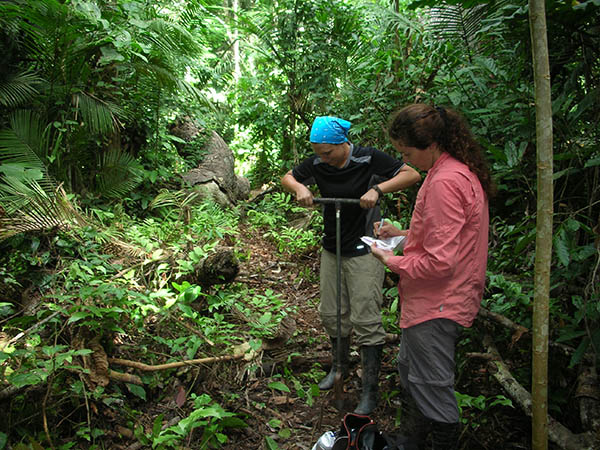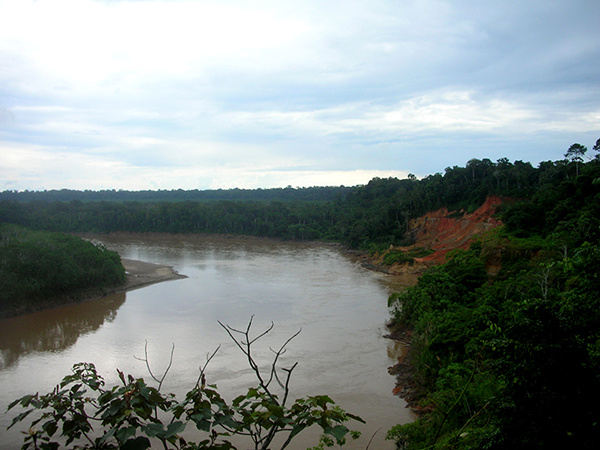
by Lucas Joel Monday, June 18, 2012

Crystal McMichael (right) and undergraduate student Monica Zimmerman collect soil cores from the western Amazon. The cores indicate that pre-Columbian western Amazonian populations did not disturb the rainforests. Courtesy of Crystal McMichael

The team collected soil cores from deep in the forest as well as along rivers, such as here atop a river bluff overlooking the Madre de Dios River in the Peruvian Amazon. Courtesy of Benjamin McMichael
Deep in the western Amazon rainforest, Crystal McMichael tries not to swat at the sweat bees crawling on the back of her neck as she samples the soil beneath her.
“If you swat them, they’ll sting you,” McMichael explains.
The bees are tolerated. But the payoff is worth it: Here, in one of the most remote places in the world, McMichael, a paleoecologist at the University of New Hampshire in Durham, is tracking the movements and activities of ancient, pre-Columbian human populations.
Most recently, McMichael and her research team unearthed evidence that pre-Columbian western Amazonian people did not significantly disturb or alter interfluvial forests, contrary to previous suggestions.
The team’s work, which appeared last week in Science, relies on 247 soil cores, ranging in age from 500 to 2,700 years old, from 55 sites across 3 million square kilometers of central and western Amazonia. In the cores, the team documented the occurrence and distribution of two telltale signs of human activity: phytoliths, which are fossilized plant particles, and charcoal.
The presence of charcoal in a core provides evidence for human-induced landscape disturbance. The researchers attribute the charcoal to humans because high rainfall and humidity in the Amazon prevent virtually any natural forest fires from igniting. Phytoliths can help researchers tell whether deforestation occurred. For instance, if most of the phytoliths in a core are arboreal, then the human impact at the site in question was likely low.
“There is a general lack of both charcoal and disturbance-indicating phytoliths in our soil cores,” says McMichael, who conducted the research as a graduate student at Florida Institute of Technology. “This means many areas of western Amazonia were never heavily deforested.”
Inferring whether pre-Columbian populations significantly altered forests has implications for debates surrounding the present-day deforestation of the Amazon.
“The idea that most of Amazonia was a modified landscape only 500 years ago sets up the assumption that the forests are resilient to disturbance,” McMichael says. “However, our data imply that a broad area was never altered, so we can’t actually say how resilient the rainforest is to change, particularly in the light of current alterations.”
McMichael and her team also found that cores from riverine areas contain almost as little evidence for human activity as interfluvial cores. Because river sites are typically more populated than interfluvial areas, it was thought that riverine cores would yield a relatively stronger human activity signal. Thus, this study helps place constraints on the geographical extent of ancient Amazonian populations, says Mike Heckenberger, an archaeologist at the University of Florida who was not involved in the study.
“Recent research suggests there were substantial human populations in some areas of Amazonia. But this paper gives us pause not to extrapolate that pattern too far, as a significant part of the western half of Amazonia may have been sparsely populated,” he says. Very little is known about this region’s ecological and archaeological past, he says, and this study shows that researchers can’t assume that what humans were doing in one place was also happening across broader areas.
© 2008-2021. All rights reserved. Any copying, redistribution or retransmission of any of the contents of this service without the expressed written permission of the American Geosciences Institute is expressly prohibited. Click here for all copyright requests.